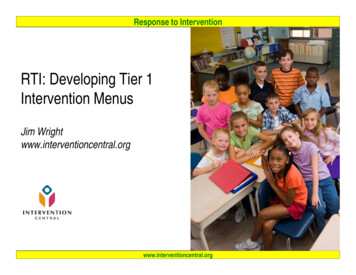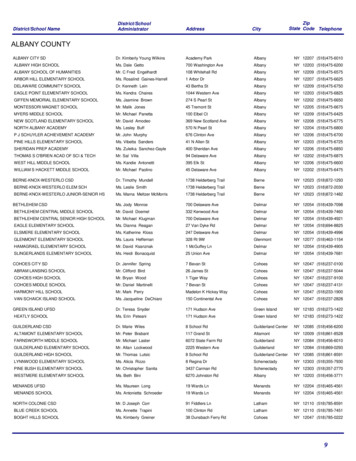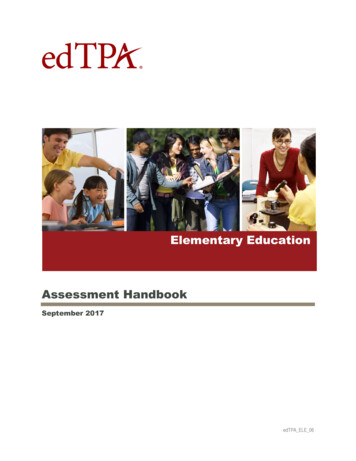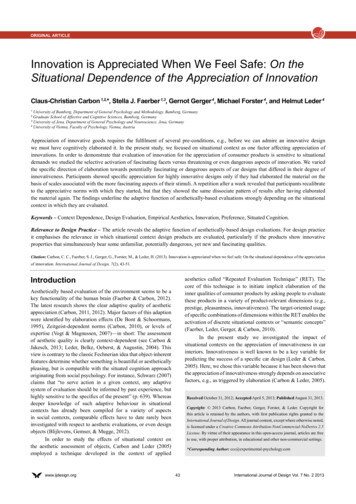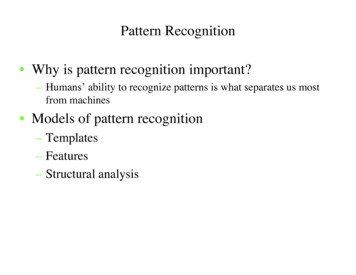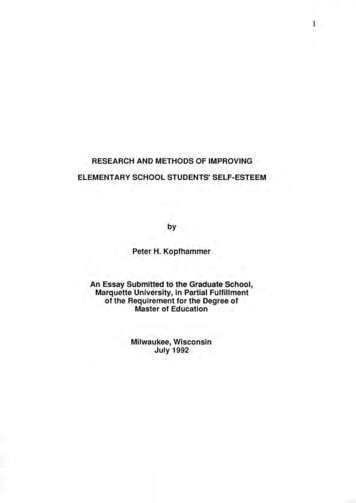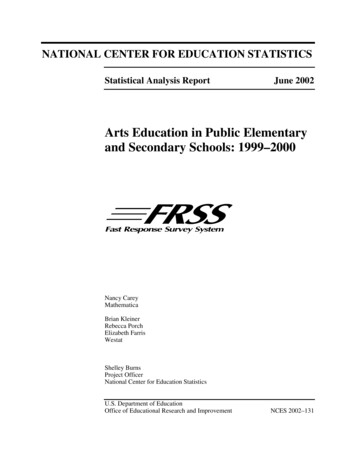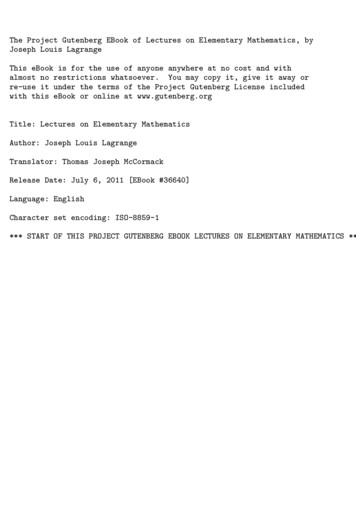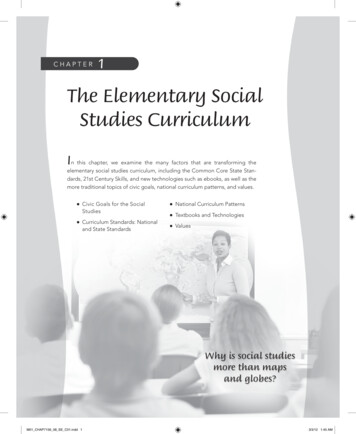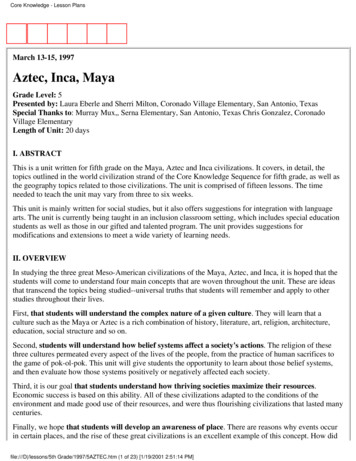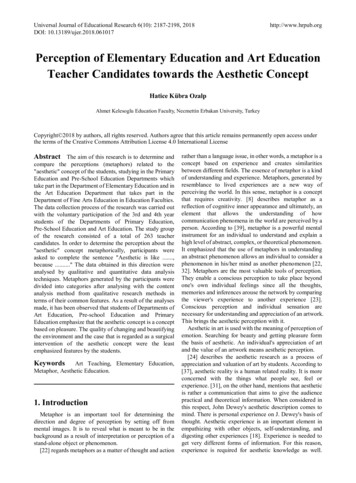
Transcription
Universal Journal of Educational Research 6(10): 2187-2198, 2018DOI: ption of Elementary Education and Art EducationTeacher Candidates towards the Aesthetic ConceptHatice Kübra OzalpAhmet Kelesoglu Education Faculty, Necmettin Erbakan University, TurkeyCopyright 2018 by authors, all rights reserved. Authors agree that this article remains permanently open access underthe terms of the Creative Commons Attribution License 4.0 International LicenseAbstract The aim of this research is to determine andcompare the perceptions (metaphors) related to the"aesthetic" concept of the students, studying in the PrimaryEducation and Pre-School Education Departments whichtake part in the Department of Elementary Education and inthe Art Education Department that takes part in theDepartment of Fine Arts Education in Education Faculties.The data collection process of the research was carried outwith the voluntary participation of the 3rd and 4th yearstudents of the Departments of Primary Education,Pre-School Education and Art Education. The study groupof the research consisted of a total of 263 teachercandidates. In order to determine the perception about the"aesthetic" concept metaphorically, participants wereasked to complete the sentence "Aesthetic is like .,because ." The data obtained in this direction wereanalysed by qualitative and quantitative data analysistechniques. Metaphors generated by the participants weredivided into categories after analysing with the contentanalysis method from qualitative research methods interms of their common features. As a result of the analysesmade, it has been observed that students of Departments ofArt Education, Pre-school Education and PrimaryEducation emphasize that the aesthetic concept is a conceptbased on pleasure. The quality of changing and beautifyingthe environment and the case that is regarded as a surgicalintervention of the aesthetic concept were the leastemphasized features by the students.Keywords Art Teaching, Elementary Education,Metaphor, Aesthetic Education.1. IntroductionMetaphor is an important tool for determining thedirection and degree of perception by setting off frommental images. It is to reveal what is meant to be in thebackground as a result of interpretation or perception of astand-alone object or phenomenon.[22] regards metaphors as a matter of thought and actionrather than a language issue, in other words, a metaphor is aconcept based on experience and creates similaritiesbetween different fields. The essence of metaphor is a kindof understanding and experience. Metaphors, generated byresemblance to lived experiences are a new way ofperceiving the world. In this sense, metaphor is a conceptthat requires creativity. [8] describes metaphor as areflection of cognitive inner appearance and ultimately, anelement that allows the understanding of howcommunication phenomena in the world are perceived by aperson. According to [39], metaphor is a powerful mentalinstrument for an individual to understand and explain ahigh level of abstract, complex, or theoretical phenomenon.It emphasized that the use of metaphors in understandingan abstract phenomenon allows an individual to consider aphenomenon in his/her mind as another phenomenon [22,32]. Metaphors are the most valuable tools of perception.They enable a conscious perception to take place beyondone's own individual feelings since all the thoughts,memories and inferences arouse the network by comparingthe viewer's experience to another experience [23].Conscious perception and individual sensation arenecessary for understanding and appreciation of an artwork.This brings the aesthetic perception with it.Aesthetic in art is used with the meaning of perception ofemotion. Searching for beauty and getting pleasure formthe basis of aesthetic. An individual's appreciation of artand the value of an artwork means aesthetic perception.[24] describes the aesthetic research as a process ofappreciation and valuation of art by students. According to[37], aesthetic reality is a human related reality. It is moreconcerned with the things what people see, feel orexperience. [31], on the other hand, mentions that aestheticis rather a communication that aims to give the audiencepractical and theoretical information. When considered inthis respect, John Dewey's aesthetic description comes tomind. There is personal experience on J. Dewey's basis ofthought. Aesthetic experience is an important element inempathizing with other objects, self-understanding, anddigesting other experiences [18]. Experience is needed toget very different forms of information. For this reason,experience is required for aesthetic knowledge as well.
2188Perception of Elementary Education and Art Education Teacher Candidates towards the Aesthetic ConceptEtymologically, aesthetic can be evaluated as theexperience of common feelings [25]. In this sense, when itis accepted as a reflection of the emotions felt by man,aesthetic is far from being a quality that exists on the objectitself. The object is now becoming a psychological thing.[34] emphasizes that aesthetic should not give a personanything other than important opportunities to take him todeep feelings and great emotions. In order to get feelingsout of the man connected to the material, it is firstnecessary to change his nature. The appearance of thethings is the work of man. The soul that is fed onappearance does no longer enjoy what it takes; it enjoyswhat it does. This separates the material at the point of truthand appearance from each other. Appearance is the realitythat exists in the material. Truth means, on the other hand,getting to the core and reaching the aesthetic reality. In thisdirection, [15] also evaluates seeing images out of objectsand designing images for objects in the same process. It isthe power of man and design to create images that aestheticthinking face in relation to objects. The interpretation ofobjects is the correspondence of previously experiencedsituations in the mind. A person can understand an artworkbetter when he/she transforms everyday experience intoaesthetic experience or lives an artistic experience.Experience aims to enable not only to understand theconcept of aesthetic experience but also to understand aperson's relationship with artworks [33]. He states thatcognitive activities such as reading poetry, listening tomusic, watching a view are cognitive actions conducted tomean the whole world, and in fact, all cognitive actionscannot be aesthetic actions basically. In order to have anaesthetic experience, it is necessary to have environmentssuch as satisfaction and appreciation. For this reason, theactual experience is not realised from the object itself butas a result of careful and cognitive examination. In theliterature, on the other hand, [26]; [10]; [12]; [15]; [19];[13]; [28]; [7]; [38] and [23] are among the studies thatintensely emphasize the importance of aesthetic experiencein understanding aesthetic. Understanding an artwork in arteducation is a case based on perception. Metaphor, aneffective method in perceptual analysis, is regarded as amethod that can be used in analyzing the perception of artconcepts. [8] mentions about two stages in theclassification of senses for visual arts. The first is anunderstanding of what kind of relation there is between theaffective forms and other forms. The other is about theanalysis of the relationship between aesthetic judgment andthe concepts we recognize and encounter in the world.According to [14]'s perceptual metaphor theory, people canunderstand and classify the phenomena that they see, hear,and feel better than the phenomena that they cannot see,hear, or feel. For this reason, people systematically try toconceptualize abstract concepts such as time, life, andemotions with concrete concepts. The fact that aesthetic isan abstract concept in art education requires theinvestigation of concrete facts to explain it. For this reason,metaphor is the determiner in the analysis of the perceptionthat occurs with experience in the field of art education,and the extraction of cognitive information. There are alimited number of studies on metaphors in the field of arteducation. [9]; [30]; [29]; [20]; [35]; [21]; [1]; [11]; [17];[6]; [16] and [4] are some of the studies on the necessity ofusing metaphors in education and fine arts education.However, besides the field of art education, no research,conducted on the metaphor analysis related to the conceptof aesthetic in the field of Elementary Education wasfound.In this direction, the main purpose of the study is toreveal and compare the aesthetic concept perceptions of theteacher candidates who took a course related to the visualarts and studying in the Departments of ElementaryEducation and Art Education. Within the framework of thisgeneral objective, answers to the following questions weresought; “How are students' perceptions related to theaesthetic concept?”, and “What are the differences in the"aesthetic" concept perceptions of the students studying inthe Elementary Education Department and in the ArtEducation Department?”2. MethodThe phenomenological approach from qualitativeresearch methods constitutes the model of the research.This approach aims to reveal how a concept is perceivedand how experiences influence the perception. Accordingto [27], the phenomenological approach is suitable forstudying effective, emotional, and often intense humanexperiences. In his work on explanation of examples indifferent fields of art with a metaphoric language, as theworld of art is becoming more diverse, [36] states that theuse of the conceptual metaphor theory in researches is anappropriate method for revealing which art forms areperceived by what kind of audiences and how.2.1. Working GroupTable 1. Demographic Characteristics of 356(64,7)(35,2)544(93,1)(6,8)Participants of the study consists of 3rd and 4th gradestudents studying in the Primary Education and Pre-SchoolEducation Departments of Elementary Education and 3rdand 4th grade students studying in the Art Education
Universal Journal of Educational Research 6(10): 2187-2198, 2018Department of Necmettin Erbakan University, AhmetKeleşoğlu Education Faculty in the 2017-2018 Educationyear, Spring Semester.A total of 263 people consisting of 67 (25,4%) maleand 196 (74,5%) female students participated in theresearch. The distribution of the students according totheir departments is as follows: 46 (17,4%) students fromthe Art Education Department, 159 students (60,4%) fromthe Pre-school Education Department and 58 (22%)students from the Primary Education Departmentparticipated in the research. 39 (84,7%) female and 7(15,2%) male students from the Art Education Department,103 (64,7%) female and 56 (%35,2) male students fromthe Pre-school Education Department, and 54 (93,1%)female and 4 (6,8%) male students from the PrimaryEducation Department participated in the study.2.2. Data Collection ToolsIn order to reveal the perceptions of the participantsabout the concept of "aesthetic", a form consisting of thesentence "Aesthetic is like., because. " wasused as a data collection tool.2.3. Collection of the DataIn order to reveal the metaphors participants have aboutthe concept of "aesthetic" they were asked to complete the"Aesthetic .is like, because." sentence. Forthis purpose, teacher candidates were given a blank formwith the sentence written at the top of the page, and theywere asked to express their thoughts by using thissentence and concentrating only on a single metaphor.Metaphors are used as a method to understand theperception of a concept in educational researches.Flannery (1991) argues that the only way to understandour experiences is to relate the things we know to theunknown, cited, [19]. In this research, where metaphorswere used as a research tool, the concept of "like" wasused to associate the link between the subject and thesource of the metaphor more clearly. By giving place tothe concept of "because" here, participants were asked toprovide a rationale or logical basis for their ownmetaphors.2.4. Analysis of the DataThe analysis of the data was carried out by coding andsorting the metaphors developed by the participants,compiling the metaphor images, developing categories,and interpreting these categories by means of contentanalysis. In the stage of category development, themetaphorical images generated by the participants werebasically examined in terms of their commoncharacteristics regarding the concept of "aesthetic". Theexpert examination or expert opinion, which is one of the2189strategies mentioned by [27], was applied for the internalvalidity and credibility of the study. The data obtained inthis direction were analysed by two experts together withthe researcher, and the categories were formed after thecollective opinion was provided at the end of the analysis.3. Findings and CommentsAccording to the general findings obtained in thisresearch, teacher candidates studying in the ElementaryEducation Department and Art Education Department ofthe Faculty of Education generated a total of 219 validmetaphors related to the concept of aesthetic. In this section,each metaphor image, produced by the participants wasanalyzed for the subject of the metaphor and therelationship between the subject and the source of themetaphor. [13] states that the source and the target must beclearly distinguishable when determining if the metaphor isclearly related to the situation or not. Categories should becreated by determining which phenomena and associationsthe metaphor corresponds to according to the impact areaof the source. In this direction, each metaphorcorresponding to the aesthetic concept in mind wasassociated with a theme and a total of 9 differentconceptual categories have been created. Table 2 containsthe classification properties of the categories compiledduring the category development phase.Table 2. Properties Used in the Classification of Generated MetaphorsAesthetic concept emphasizing the beauty in the nature withorder, peace and harmony- Everything that is natural- The harmony in the unity and solidarity on the earth- Nature is visually beautifulAesthetic concept emphasizing the expression of emotionswithin a person-Reflect the inner beauty of a person-Expression-Reflection of good feelingsThe relative aesthetic concept that changes according to theperson-Change from person to person-Change from age to ageAesthetic concept based on feeling pleasure-Activate pleasant sentiments-Arouse the feeling of pleasureAesthetic concept accepted as a science of beauty-Investigate the beauty in art-Search for the beautyThe aesthetic concept that gives the person a differentperspective-Realize the beauty-Gain the ability to predictAesthetic concept that changes and beautifies the environment-Show something different from it is-Make a bad situation elegant, beautify itAesthetic concept bearing a vital importance-Add vitality to lifeAesthetic concept as a surgical intervention-Change a disliked physical property
2190Perception of Elementary Education and Art Education Teacher Candidates towards the Aesthetic Concept3.1. General FindingsAfter the examination of the phenomena that the 263 students who participated in the research visualized in their minds,a total of 219 valid metaphors that teacher candidates studying in the Elementary Education Department and the ArtEducation Department of the Faculty of Education produced in relation with the concept of aesthetic were classified. As aresult of the classification, metaphors were categorized as follows; aesthetic concept emphasizing the beauty in the naturewith order, peace and harmony, aesthetic concept emphasizing the expression of emotions within a person, the relativeaesthetic concept, changing according to the person, aesthetic concept based on feeling pleasure, aesthetic conceptaccepted as a science of beauty, aesthetic concept that gives the person a different perspective, aesthetic concept thatchanges and beautifies the environment, aesthetic concept bearing a vital importance and aesthetic concept accepted as asurgical intervention. The metaphors, included in the created categories are presented in the following tables according tothe student numbers and the departments they are in.Table 3. Distribution of Categories According to nArt EducationPrimaryEducationf%f%f%Aesthetic concept emphasizing the beauty in the nature with order, peaceand harmony715,92616,8712,2Aesthetic concept emphasizing the expression of emotions within a person12,21811,6610,5The relative aesthetic concept that changes according to the person36,82415,547Aesthetic concept based on feeling pleasure22503321,41831,5Aesthetic concept accepted as a science of beauty715,9127,71119,2The aesthetic concept that gives the person a different perspective36,895,847Aesthetic concept that changes and beautifies the environment-0,42415,535,2Aesthetic concept bearing a vital importance12,253,235,2Aesthetic concept as a surgical n we look at the distribution of the categoriesformed by the generated metaphors according to thedepartments in Table 3, it is observed that the students ofthe Art Education Department emphasized the aestheticconcept which is based on feeling pleasure the most with22 (50%) repeats. Beside this, it is seen that the secondmost emphasized categories are the aesthetic conceptemphasizing the beauty in the nature with order, peace andharmony and the aesthetic concept accepted as a science ofbeauty with 7 (15, 9) repeats. The categories of the relativeaesthetic concept that changes according to the person andthe aesthetic concept that gives the person a differentperspective take part with a rate of 3 (%6, 8). Thecategories of the aesthetic concept emphasizing theexpression of emotions within a person and the aestheticconcept bearing a vital importance are at the minimum ratewith 1 (%2, 2) repeat. There were no metaphors generatedin the categories of the aesthetic concept that changes andbeautifies the environment and the aesthetic concept as asurgical intervention. It is observed that the students of thePre-school Education Department emphasized the aestheticconcept based on feeling pleasure the most with 33 (21, 4%)repeats. The Aesthetic concept emphasizing the beauty inthe nature with order, peace and harmony has been thesecond most emphasized category with a rate of 26 (%16,8)repeats. It has been observed that the categories of theaesthetic concept that changes and beautifies theenvironment and the relative aesthetic concept that changesaccording to the person were emphasized at a rate of 24(%15, 5) repeats. It is seen that the category of the aestheticconcept emphasizing the expression of emotions within aperson has been emphasized with 18 (%11, 6) repeats. 12(7, 7%) metaphors were generated in the category of theaesthetic concept accepted as a science of beauty. Thenumber of 9 (5, 8%) repeats can be seen in the category ofthe aesthetic concept that gives the person a differentperspective. It is seen that the category of the aestheticconcept bearing a vital importance with a repeat rate of 5(%3, 2) and the category of aesthetic concept as a surgicalintervention with a repeat number of 3 (%1, 9) are thecategories with the least number of metaphors. Thecategories of the aesthetic concept based on feelingpleasure with a rate of 18 (%31, 5) and the aestheticconcept accepted as a science of beauty with a rate of 11(%19, 2) have been emphasized in the first place among themetaphors generated by the students studying in thePrimary Education Department. 7 (12, 2%) metaphorswere generated in the category of aesthetic concept
Universal Journal of Educational Research 6(10): 2187-2198, 2018emphasizing the beauty in the nature with order, peace andharmony. It can be seen that the aesthetic conceptemphasizing the expression of emotions within a personcategory has got a repeat number of 6 (6, 5%). The repeatnumbers of the aesthetic concept that gives the person adifferent perspective and the relative aesthetic concept thatchanges according to the person are both 4 (7%). In thesame way, it can be seen that the aesthetic concept bearinga vital importance category and the aesthetic concept thatchanges and beautifies the environment category both haveequal repeat numbers with a rate of 3 (5, 2%). Finally, theaesthetic concept as a surgical intervention category hasbeen the least emphasized category with a repeat rate of 1(1, 7%). The distribution of the metaphors generated in theresearch according to the categories and the departments isgiven in the table below.Table 4. Distribution of the Generated Metaphors by CategoriesDepartmentsMetaphors by Categories (n 219)Aesthetic concept emphasizing the beauty in the nature with order, peace and harmony ( n 28)Art EducationDepartmentPre-school EducationDepartmentPrimary EducationDepartmentA natural thing 1, a sunset view 1, the beautiful and the ugly 1, the world 1, a colourful butterfly 1, a tree 1, thenature 1.The order of the universe 1, a human body 1, mathematics 1, the nature 8, the harmony of the universe 1, a rosein the nature 1, water 2, a puzzle 1, the night and the day 1, a symmetry 1, the outer appearance of an element 1,a rainbow 1, the harmony and order 1, a pattern 1, a soul 1, a camomile 1, a gold ratio 1, a painting 1.An untouched nature 1, looking at a nature view 1, a tree 1, the nature 1, the sky 1, a sea 1, a honeycomb 1.Aesthetic concept emphasizing the expression of emotions within a person (n 20)Art EducationDepartmentPre-school EducationDepartmentPrimary EducationDepartmentThe beauty within a person 1.The order of the inner beauty 1, beauty 1, a book 2, painting a blank canvas 1, a mirror 4, a human being 1, aphoto 2, a beautiful picture 1, a rotten apple 1, a sea 1, a melon 1, robots 1, a rose 1.A reflection of what we see and experience on us 1, a light reflected from the world of imagination 1, thebeauty of the nature 1, tea 1, reflecting the inner beauty 1, the inner reflection of a person 1.The relative aesthetic concept that changes according to the person (n 30)Art EducationDepartmentPre-school EducationDepartmentPrimary EducationDepartmentA moving sky 1, a changing canvas 1, love 1.Fashion 1, a personalized beauty 1, an individualized beauty 1, a relative concept 1, mud 1, a measurement 1,clouds 1, the inner child 1, the sky 1, a personalized art 1, a hobby 2, a painting 1, a camomile 1, a rubber 1, awindow 1, a mirror 1, the world 1, a meal you do not know what it tastes like 1, having breakfast in the view 1,an extraordinary beauty, pleasing to the eye 1, pastry dough 1, the perception of beauty changing from personto person 1, looking at the clouds 1.The beauty that looks nice when we look at 1, life 1, a human being 1, gymnastics 1.Aesthetic concept based on feeling pleasure (n 67)Art EducationDepartmentPre-school EducationDepartmentPrimary EducationDepartmentLove 2, the visual size of the concern 1, the flexible body of a ballerina 1, eating your favourite dish 1, pleasure1, a bar of chocolate 1, elegancy 1, an explosion 1, a heart addressing emotions 1, anything eye-pleasing 1,watching a film 1, impartial 1, the feeling of pleasure 1, the world 1, a perfume 1, a like, pleasure, a beauty 1,running in a spike field 1, the nature 1, all colours of the rainbow 1, a delicious dish 1, imagination 1,Excellence that looks nice 1, art 1, me 1, a very green Black Sea highland 1, a little child 1, a stare into space 1,a scenery 2, the delight in each human eye 1, love 1, nice jokes 1, an emotion 2, ourselves 1, describing a word1, a heart-warming fondue 1, a perfect looking painting 1, a butterfly 1, the sun 3, the rhythm of music 1, love1, a towel 1, something that satisfies a person's sense of pleasure 1, a smooth nose 1, pleasing to the ear and eye1, a wind in a hot weather 1, a rose 2, a mountain view 1, eating 1, a tres leches cake 1.A life sweetening candy 1, concrete 1, a source of peace 1, the spring 1, slime 1, a sea 1, Neşet Ertaş songs 1, abeautiful rose 1, a nice odour 1, a moon 1, the beauty in which we feel ourselves happy 1, a delicious meal 1,fine details of life 1, a bud 1, our beloved ones 1, spots of a ladybug 1, a swan 1, a cigarette 1.Aesthetic concept accepted as a science of beauty (n 23)Art EducationDepartmentPre-school EducationDepartmentPrimary EducationDepartmentThe science of beauty 1, seeing and feeling 1, look for the beauty 1, a colourful flower 1, better, more beautiful1,a flower 1, a paradise filled with beauties 1.Beauty 1, a spectacular football game 1, the touch that beautifies the world 1, a flower 1, water 1, describingthe sky to a blind 1, a woman 2, a leafy flower 1, pleasing to the eye 2, a poem 1.Beauty 5, the revitalization of the nature in the spring 1, Guernica 1, eyes of a person 1, the thing pleasing to theeye 1, an effort to present the beauty 1, to look beautiful 1.The aesthetic concept that gives the person a different perspective (n 14)Art EducationDepartmentPre-school EducationDepartmentPrimary EducationDepartment2191A different perspective 1, looking at the life from a different angle 1, different people come together 1.A perspective on life 1, a rainbow 1, pink glasses 1, a quiet stream 1, eye-glasses 1, a sea 1, a new life 1, the sun1, an ink stain test 1.Our viewpoint for the world 1, the look of each person in the mirror 1, falling in love 1, the sun 1.
2192Perception of Elementary Education and Art Education Teacher Candidates towards the Aesthetic ConceptDepartmentsMetaphors by Categories (n 219)Aesthetic concept that changes and beautifies the environment (n 25)Art EducationDepartmentPre-school EducationDepartmentPrimary EducationDepartmentA change in a positive direction 1, a magic 4, a sparkle 1, the ripening of a fruit 1, harmony and elegancy 1, anadjustment and change with no beginning and end 1, a modification 1, a restoration 1, a flower 1, a see 1,multicoloured 1, wine 1, brushstrokes 1, being reborn 1, restoration 1, salvation 1, a tree on the prairie 1, apicture frame 1, a child 1, a kite 1, a diamond 1.The life 1, rasped wood 1, Lokman Hekim’s invention of Immortality Elixir 1.Aesthetic concept bearing a vital importance (n 8)Art EducationDepartmentPre-school EducationDepartmentPrimary EducationDepartmentWater 1.Air 2, music 1, a kitchen 1, a piece completing the man 1.A pickle 1, water 1, bread 1,Aesthetic concept as a surgical intervention (n 4)Art EducationDepartmentPre-school EducationDepartmentPrimary EducationDepartmentA plastic surgeon 1, a revitalization of man 1, Ajda Pekkan 1.The National Lottery 1.Metaphors generated in Table 4 are classified accordingto the departments and categories. Looking at thisclassification in general, it is observed that students of theArt Education Department produced metaphors in theaesthetic concept based on feeling pleasure category themost. Metaphors such as love (2), the flexible body of aballerina (1), eating your favourite dish (1), pleasure (1), abar of chocolate (1), elegancy (1), an explosion (1),anything eye-pleasing (1), watching a film (1), the feelingof pleasure (1) and a perfume (1) are some of the mostobvious examples in this category. Meanwhile, examplessuch as an emotion (2), a butterfly (1), the sun (3), therhythm of music (1), love (1), a towel (1), something thatsatisfies a person's sense of pleasure (1), a wind in a hotweather (1), a rose (2), a mountain view (1) and a treslechescake (1) can be given for this category in which students ofthe Pre-school Education generated the most metaphors atthe same time. Metaphors such as a sea (1), Neşet Ertaşsongs (1), a beautiful rose (1), a nice odour (1), a moon (1),the beauty in which we feel ourselves happy (1) anddelicious meal (1) take part among the examples that thestudents of the Primary Education generated for the samecategory. In the category of the aesthetic conceptemphasizing the expression of emotions within a person,students express their opinion that the aesthetic is a moreemotion-based concept. The students of the Art EducationDepartment produced very few metaphors related to thiscategory. The only metaphor generated in this area is thebeauty within a person (1). Some of the metaphorsgenerated by the students of the Pre-school EducationDepartment can be listed as; the order of the inner beauty(1), beauty (1), a book (2), a painting a blank canvas (1), amirror (4), a human being (1), a photo (2), a beautifulpicture (1), a rotten apple (1), a sea (1) and a melon (1). Inthis section, the students of the Primary EducationDepartment used the expressions of the beauty of thenature (1), tea (1), reflecting the inner beauty (1), as ametaphor. According to the metaphors generated by thestudents of the Art Education Department about the natureand the order of the universe, the beautiful and the ugly (1),the world (1), a colourful butterfly (1), a tree (1) and thenature (1) take part in the category of the aesthetic conceptemphasizing the beauty in the nature with order, peace andharmony. Within the same category, the students of thePre-school Education Department produced metaphors inthe form of the order of the universe (1), a human body (1),mathematics (1), the nature (8) and the harmony of theuniverse (1). The metaphors of the students of the PrimaryEducation in this category can be listed as a tree (1), thenature (1), the sky (1), a sea (1) and a honeycomb (1). Forthe category of aesthetic concept accepted as a science ofbeauty, it is observed that the theme of
different fields of art with a metaphoric language, as the world of art is becoming more diverse, [36] states that the use of the conceptual metaphor theory in researches is an appropriate method for revealing which art forms are perceived by what kind of audiences and how. 2.1. Working G ro

